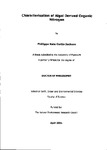Characterisation of Algal Derived Organic Nitrogen
| dc.contributor.author | Curtis-Jackson, Phillippa Kate | |
| dc.contributor.other | School of Geography, Earth and Environmental Sciences | en_US |
| dc.date.accessioned | 2013-10-08T09:11:52Z | |
| dc.date.available | 2013-10-08T09:11:52Z | |
| dc.date.issued | 2006 | |
| dc.identifier | NOT AVAILABLE | en_US |
| dc.identifier.uri | http://hdl.handle.net/10026.1/2076 | |
| dc.description.abstract |
The molecular level characterisation of compounds comprising the dissolved organic nitrogen (DON) pool is an important task for chemical oceanographers wishing to understand its role in the marine N cycle. Low DON concentrations, problems with saline matrices and a lack of pre-concentration methods have all contributed to DON being ignored and disregarded, until recently. Sub units of DON have been analysed as bulk parameters within which the low molecular weight (LMW; < 1,500 Da) fraction has been proposed to drive regenerated production within the oceans. The largest producers of these compounds are phytoplankton. Dissolved combined amino acids (DCAAs) are proposed to be the largest identifiable component of the LMW fraction. Peptides were chosen as the starting point for this study on DON characterisation, due to their unrivalled detection when analysed via liquid chromatography/ mass spectrometry (LC/MS). A method was developed for the characterisation of low molecular weight peptides, released either actively or passively from the axenically-cultured phytoplankton Phaeodactylum tricornutum. Methods for the separation (high performance liquid chromatography; HPLC), detection (mass spectrometric; MS), de-salination and pre-concentration (solid phase extraction; SPE), of analytes present in the culture water sampled during the period of maximum DON, were developed. The successful chromatographic separation of LMW peptides was achieved using a Phenomenex® Gemini Gig column in conjunction with mobile phases of acidified MeOH and water. The SPE method was developed on a Hamilton PRP-1 column containing a polystyrene divinylbenzene stationary phase (PSDVB). During the extraction process the increased hydrophobicity of the PS-DVB phase was predicted to yield increased recoveries of peptides, when compared to analogous d g phase cartridges. The method was transferred to extraction cartridges (500 mg, StrataX). Further investigations were then carried out into the affects of salt and dissolved organic matter on the extraction process. Samples were prepared by applying the extraction method to 1 L supernatants of culture water samples. The HPLC protocol was used to separate the components of the complex sample prior to data acquisition in both full MS mode and in the data dependent mode (DDMS). Mass spectra and chromatograms of ions unique to the cultured waters were identified. Further instrument manipulation allowed interfering ions to be diverted away from the mass analyser and consequently multistage mass spectrometry (MS²) to be carried out on unique ions that exceeded the threshold intensity of 1 x 105. Unique ions identified in the axenic cultures were two amino acids TYR and a modified structure isomerically/isobarically related to TYR. Seven peptides were partially sequenced. These were H-(VAL, THR, Xxx)-OH, H-(GLN/LYS, ALA, ASN, Xxx)-OH, H-(ASN, ALA, GLU, Xxx)-OH, H-(VAL, GLU, Xxx)-OH, H-(SER, HIS, Xxx)-OH, H- (PRO, XLE,HIS, GLN/LYS, GLY, Xxx)-OH and H-(Xxx, XLE, GLN/LYS, XLE, GLU)- OH. One whole peptide was tentatively proposed as H-TRP-PHE-OH. A significant loss of data was observed between the unique peptide ions identified in the MS analysis and the ions that underwent CID during the DDMS analysis, because they were below the threshold ion count or co-eluted with a more dominant ion. The method development carried out through this study has enabled the successful analysis of samples previously considered incompatible with LC/MS instrumentation. The method can be applied to all aquatic environment samples for both contaminant removal and preconcentration requirements and can be seen as an initial step from which many different avenues of future work may be explored. | en_US |
| dc.language.iso | en | en_US |
| dc.publisher | University of Plymouth | en_US |
| dc.title | Characterisation of Algal Derived Organic Nitrogen | en_US |
| dc.type | Thesis | |
| plymouth.version | Full version | en_US |
| dc.identifier.doi | http://dx.doi.org/10.24382/3257 | |
| dc.identifier.doi | http://dx.doi.org/10.24382/3257 |
Files in this item
This item appears in the following Collection(s)
-
01 Research Theses Main Collection
Research Theses Main


